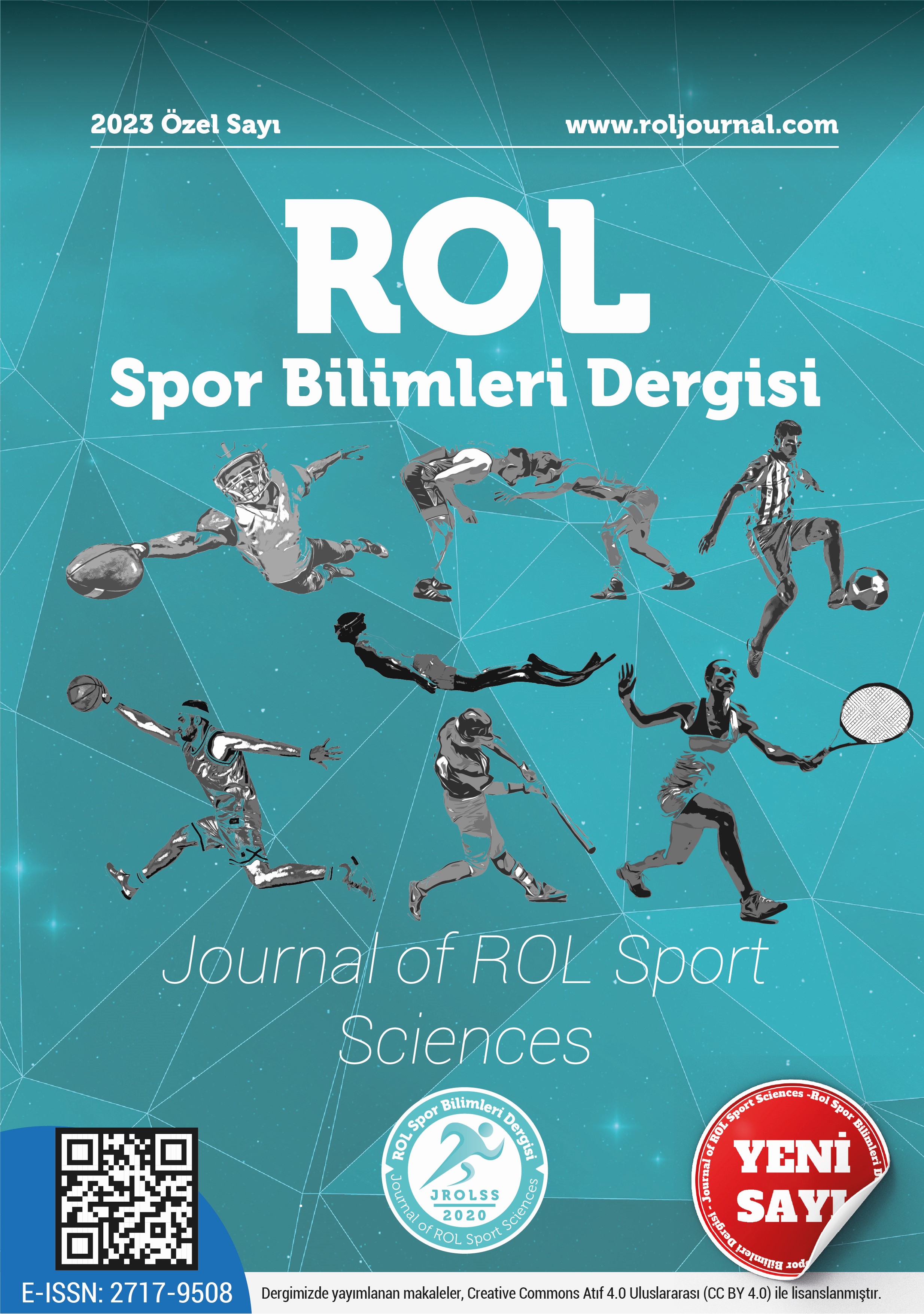The effect of physical activity on body composition and blood lipids after sleeve gastrectomy surgery in adult obese women – A one year longitudinal study
DOI:
https://doi.org/10.5281/zenodo.10008138Keywords:
Body composition, blood lipids, obesity, physical activity, sedentary lifestyleAbstract
Obesity is a global health problem that is increasing in prevalence and poses significant risks to the health of individuals. In recent years, bariatric surgery, especially sleeve gastrectomy, has become a widely adopted approach in the treatment of obesity. However, the role of post-operative physical activity, especially in women, has not been adequately studied. The aim of this study is to compare the body composition and blood lipid levels of adult obese women who do physical activity and those who do not for a year after bariatric surgery. Twenty-one women (PA group / non-PA group) participants with a sedentary lifestyle and a body mass index above 35 were included in the study. The PA group performed regular aerobic exercises, while the non-PA group maintained a sedentary lifestyle. Measurements were made in both groups preoperatively, at 1, 3, 6 and 12 months. The results showed that physical activity has a significant effect on body composition. Regarding blood lipid levels, physical activity contributed to significantly improvements in cholesterol, low-density lipoprotein and triglyceride levels over the 12-month period. However, no significant relationship was found between physical activity and high-density lipoprotein levels. In summary, this study highlights the beneficial effects of physical activity on body composition and some blood lipid parameters in women after sleeve gastrectomy.
References
ACSM. (2013). ACSM's guidelines for exercise testing and prescription. Lippincott williams & wilkins.
Arterburn, D. E., Telem, D. A., Kushner, R. F., & Courcoulas, A. P. (2020). Benefits and risks of bariatric surgery in adults: A review. Jama, 324(9), 879-887.
Bond, D. S., Phelan, S., Wolfe, L. G., Evans, R. K., Meador, J. G., Kellum, J. M., … et al. (2009). Becoming physically active after bariatric surgery is associated with improved weight loss and health‐related quality of life. Obesity, 17(1), 78-83.
Buchwald, H. (2014). The evolution of metabolic/bariatric surgery. Obesity Surgery, (24), 1126-1135.
Chevallier, J.-M., Paita, M., Rodde-Dunet, M.-H., Marty, M., Nogues, F., Slim, K., … et al. (2007). Predictive factors of outcome after gastric banding: a nationwide survey on the role of center activity and patients' behavior. Annals of Surgery, 246(6), 1034-1039.
Cohen, J. (2013). Statistical power analysis for the behavioral sciences. Routledge.
Colles, S. L., Dixon, J. B., & O’Brien, P. E. (2008). Hunger control and regular physical activity facilitate weight loss after laparoscopic adjustable gastric banding. Obesity Surgery, 18(7), 833-840.
Dixon, J. B., O’Brien, P. E., Playfair, J., Chapman, L., Schachter, L. M., Skinner, S., … et al. (2008). Adjustable gastric banding and conventional therapy for type 2 diabetes: A randomized controlled trial. Jama, 299(3), 316-323.
In, G., Taskin, H. E., Al, M., Alptekin, H. K., Zengin, K., Yumuk, V., & Ikitimur, B. (2021). Comparison of 12-week fitness protocols following bariatric surgery: aerobic exercise versus aerobic exercise and progressive resistance. Obesity Surgery, (31), 1475-1484.
National Institutes of Health. (1998). Clinical guidelines for the identification, evaluation, and treatment of overweight and obesity in adults-the evidence report. Obesity Research, 6(2), 51S-209S.
Jacobi, D., Ciangura, C., Couet, C., & Oppert, J. M. (2011). Physical activity and weight loss following bariatric surgery. Obes Rev, 12(5), 366-377. https://doi.org/10.1111/j.1467-789X.2010.00731.x
Larsen, J. K., Geenen, R., van Ramshorst, B., Brand, N., Hox, J. J., Stroebe, W., … et al. (2006). Binge eating and exercise behavior after surgery for severe obesity: a structural equation model. International Journal of Eating Disorders, 39(5), 369-375.
Latner, J. D., Wetzler, S., Goodman, E. R., & Glinski, J. (2004). Gastric bypass in a low‐income, inner‐city population: Eating disturbances and weight loss. Obesity Research, 12(6), 956-961.
Laukkanen, J. A., Zaccardi, F., Khan, H., Kurl, S., Jae, S. Y., & Rauramaa, R. (2016). Long-term change in cardiorespiratory fitness and all-cause mortality: A population-based follow-up study. Mayo Clinic Proceedings.
Livhits, M., Mercado, C., Yermilov, I., Parikh, J. A., Dutson, E., Mehran, A., … et al. (2010). Exercise following bariatric surgery: systematic review. Obesity Surgery, 20(5), 657-665.
Melissas, J., Koukouraki, S., Askoxylakis, J., Stathaki, M., Daskalakis, M., Perisinakis, K., … et al. (2007). Sleeve gastrectomy—a restrictive procedure? Obesity Surgery, (17), 57-62.
Noël, P. H., & Pugh, J. A. (2002). Management of overweight and obese adults. Bmj, 325(7367), 757-761.
Obesity and Overweight. (2020). World Health Organization. Retrieved March 10 from https://www.who.int/news-room/fact-sheets/detail/obesity-and-overweight
Saavedra, P. I., Cano-Cappellacci, M. A., Fuentes, C. M., Montero, J. R., Pinuer, P. M., & Mercadino, A. B. (2019). Physical fitness and physical activity in women with obesity: short term effects of sleeve gastrectomy. Nutrición Hospitalaria: Organo Oficial de la Sociedad Española de Nutrición Parenteral y Enteral, 36(4), 840-845.
Shabbir, A., & Teh, J. L. (2014). A new emerging procedure–Sleeve gastrectomy. Essentials And Controversies in Bariatric Surgery, 101-124.
Shoar, S., & Saber, A. A. (2017). Long-term and midterm outcomes of laparoscopic sleeve gastrectomy versus Roux-en-Y gastric bypass: A systematic review and meta-analysis of comparative studies. Surgery for Obesity and Related Diseases, 13(2), 170-180. https://doi.org/10.1016/j.soard.2016.08.011
Sjöström, L., Lindroos, A. K., Peltonen, M., Torgerson, J., Bouchard, C., Carlsson, B., … et al. (2004). Lifestyle, diabetes, and cardiovascular risk factors 10 years after bariatric surgery. New England Journal of Medicine, 351(26), 2683-2693. https://doi.org/10.1056/NEJMoa035622
Volaklis, K. A., Halle, M., & Meisinger, C. (2015). Muscular strength as a strong predictor of mortality: a narrative review. European Journal of Internal Medicine, 26(5), 303-310.
Wändell, P., Carlsson, A., & Theobald, H. (2009). The association between BMI value and long-term mortality. International Journal of Obesity, 33(5), 577-582.
Wolfe, B. L., & Terry, M. L. (2006). Expectations and outcomes with gastric bypass surgery. Obesity Surgery, 16(12), 1622-1629.
Downloads
Published
How to Cite
Issue
Section
License
Copyright (c) 2023 Journal of ROL Sport Sciences

This work is licensed under a Creative Commons Attribution 4.0 International License.

